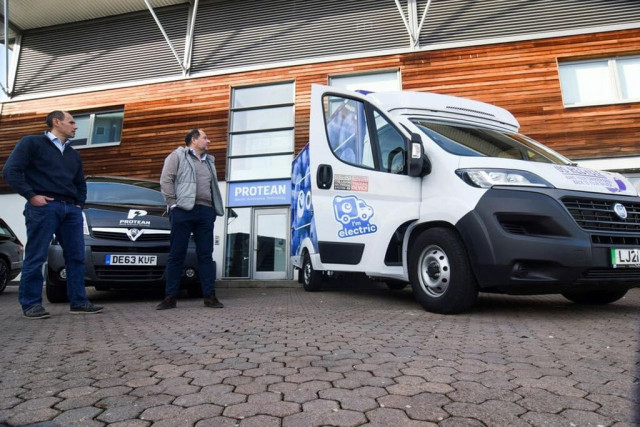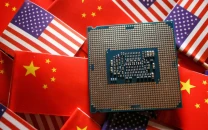EV startups hunt for an edge as big automakers roll out vans, trucks
Major automakers, motivated by the imminent bans in China, EU are working to get their electric cars to market quickly

As the traditional carmakers begin to produce electric trucks and vans, the startups have a renewed focus on finding a technological advantage to keep them on the road when their larger rivals do.
Major automakers, motivated by the imminent bans in China and Europe on combustion engines, are working hard to get their electric cars to market quickly and to avoid being caught by another Tesla (NASDAQ).
Ford can help you survive in an industry like General Motors (NYSE). Renault Stellantis and (PA) can manufacture hundreds of thousands of vans each year. Superior software or technology may make all the difference to newer competitors.
Jean-Michel Renaudie is senior vice president of industrial and commercial transport at Auto Supplier. “The startups all contribute something to the party,” Renaudie said. TE Connectivity (NYSE:). “The key question here is what your unique selling point?
Bedeo was a British EV startup. The unexpected twist of events last year changed the outcome.
China Evergrande Group was a real estate developer. In debt, the subsidiary of National Electric Vehicle Sweden put Protean Electric (NEVS) on the block. Bedeo then purchased it.
Bedeo, a Turkey-based company, had previously been creating electric vans from Opel and Peugeot’s Boxer. The company also sells its own electric vans, such as the TNT from FedEx (NYSE) and DHL from Deutsche Post (OTC).
According to Osman Boyner, Chief Executive of Bedeo, Protean plans to create new EV platforms that can be used for passenger vehicles as well as commercial vehicles, according to Reuters.
In-wheel motors are stand-alone electric motors, which can be mounted in any or all of the wheels. They don’t require axles or powertrains. This allows them to free up space within vans and trucks and extends battery life by decreasing vehicle weight.
Andrew Whitehead, chief executive of Protean is seen displaying a production-ready sportscar that was developed by NEVS. It has a range 1,000km (620 miles) and far exceeds the range of EVs.
Boyner explained that “every vehicle will someday have in-wheel engines because it’s an obvious decision.” We already have the technology and we now need to make it available for sale.
‘GORILLA IN MARKETPLACE’
These are big stakes. Worldwide, approximately 9 million delivery vans get sold annually. Global distribution and retail businesses are under increased pressure to become greener. This will lead to a surge in commercial EV sales.
Boyner indicated that Bedeo had been in contact with several major automobile manufacturers regarding the possibility of building commercial EV platform platforms. It also talked to its own investors, asking them whether they would like to do it all on their own. The decision is expected to be made by June end.
Should we spend half a million to compete with manufacturers or just supply components? He stated. He said, “These manufacturing companies are so large that they look like governments.”
Because of the large manufacturing facilities, worldwide sales and distribution network, and their long-standing customer relationships, major automakers, such as Ford and GM, can pose a challenge to startups.
Travis Katz, the chief executive of BrightDrop GM’s commercial EV company, stated, “Knowing How to Do Supply Chain at Scale is a Huge, Great Advantage.” The firm has received major orders for its mass-produced EV600 van from FedEx (NYSE:) and Walmart (NYSE.
Ford vans are a top-selling brand in Europe and the United States. Sam Fiorani (VP of Global Vehicle Forecasting, AutoForecast Solutions) said that Ford’s Transit van was “the gorilla on the market”.
Fiorani indicated that they are ready to serve any commercial buyers. That’s quite a challenge.
Rivian Automotive is a US-based startup that makes commercial vehicles, electric pickups, and SUVs. Its valuation soared 53% and surpassed $100 billion on the same day it listed its shares.
Rivian won a 100,000 van order at Amazon (NASDAQ.) But its stock price fell last month after Amazon announced it was partnering with Stellantis to offer a range of services, including cloud computing and software.
Ross Rachey of Amazon, the director for global fleet and products said that Amazon partners with established companies like Rivian or Stellantis, because it “isn’t a one-size fits all approach. There’s room to accommodate many players.”
KNOW-HOW & NETWORK
However, investors are often more cautious about startups because of the possibility that they will fail.
Imagine if these start-ups disappear five years later. Scott Schermerhorn (Managing Director at Mariner Wealth Advisors), which holds GM shares, said that.
FedEx lost its last year’s revenue when EV startup Chanje (which had offered it 1000 vans) went out of business.
FedEx Americas Head Richard Smith said that thousands of electric vans were ordered by the delivery service because they had “know-how,” the scale and the ability to access capital.
However, he stated that FedEx is open to “innovation and new technology” startups.
Ed Sun, portfolio manager and managing director at investor Engine No. According to 1 in San Francisco: Startups may not be large but they can still survive due to their better software and vehicle technology or niche.
Sun said that “the new players will clearly take share”, as he owns Ford and GM shares.
Low-cost innovation is the future for British startup Arrival Electric Vans
The company plans to create “microfactories”, and make van body parts from a lightweight, low-cost plastic composite. Its fleet management software is backed by the company’s executives who claim it offers a more reliable van than diesel alternatives at the same cost.
Swedish startup Volta Trucks holds a clear advantage over other truck companies as the 16-tonne, electric vehicle it produces will be in production later this year. With its low central seat and wrap-around windshield it puts pedestrians at the same level as drivers to increase road safety.
‘FUTURE PROOF’
British manufacturer Tevva is meanwhile aiming for the niche.
For the benefit of established automakers’ networks, “gliders” are truck frames and cabs that it purchases from them. It then adds electric motors and battery packs to the models, and sometimes hydrogen fuel cells. This transforms them into cleaner fuel with double functions that have a wider range.
Asher Bennett, chief executive of Asher Bennett stated to Reuters: “We don’t need hundreds or millions in parts that someone else is doing well.”
Tevva has been successfully testing UPS trucks and will start production in the UK this year with two models of its 7.5-tonne (7.550 kg) truck at its Tilbury plant.
The electric version will offer a 160 mile range, while the reserve hydrogen fuel cells will give it a 310 mile range. Tevva will roll out models that weigh in at 12-tonnes and 19-tonnes with hydrogen boosters.
Tevva has selected two US factories and one in Europe that can produce approximately 3000 trucks per year.
Trucking professionals believe that hydrogen cells will become the norm because they emit only water and are lighter than battery-powered vehicles. But, fuelling infrastructure remains a work in progress.
Bennett stated that the use of low-cost hydrogen manufacturing, cloud-based software and hydrogen technology to optimize vehicle ranges will make it “future-proof” for his company.
UPS said that it has been able to work with Arrival and other startups in shaping the types of electric vehicles that will be part of its 130,000-strong global fleet.
UPS and Arrival collaborated on the design of a chassis and powertrain for van bodies. UPS now has orders up to 10,000 vans.
Luke Wake, vice president for maintenance and engineering at UPS, stated that “we saw it as a solution to scale up in support of our global operations.”



















COMMENTS
Comments are moderated and generally will be posted if they are on-topic and not abusive.
For more information, please see our Comments FAQ